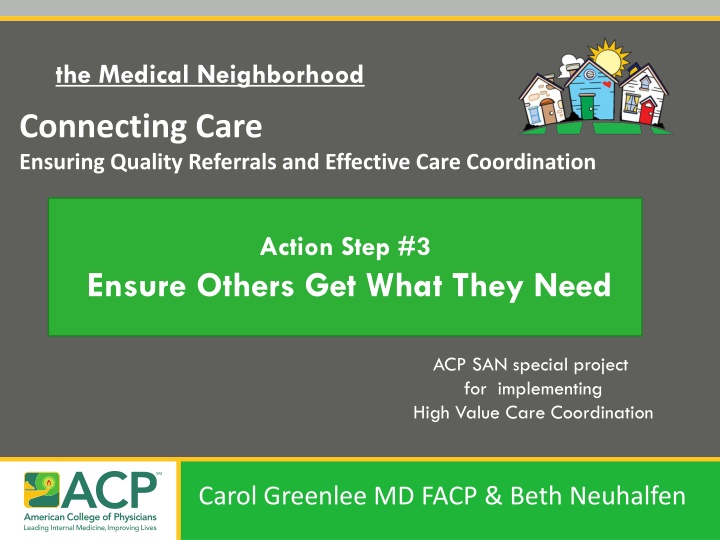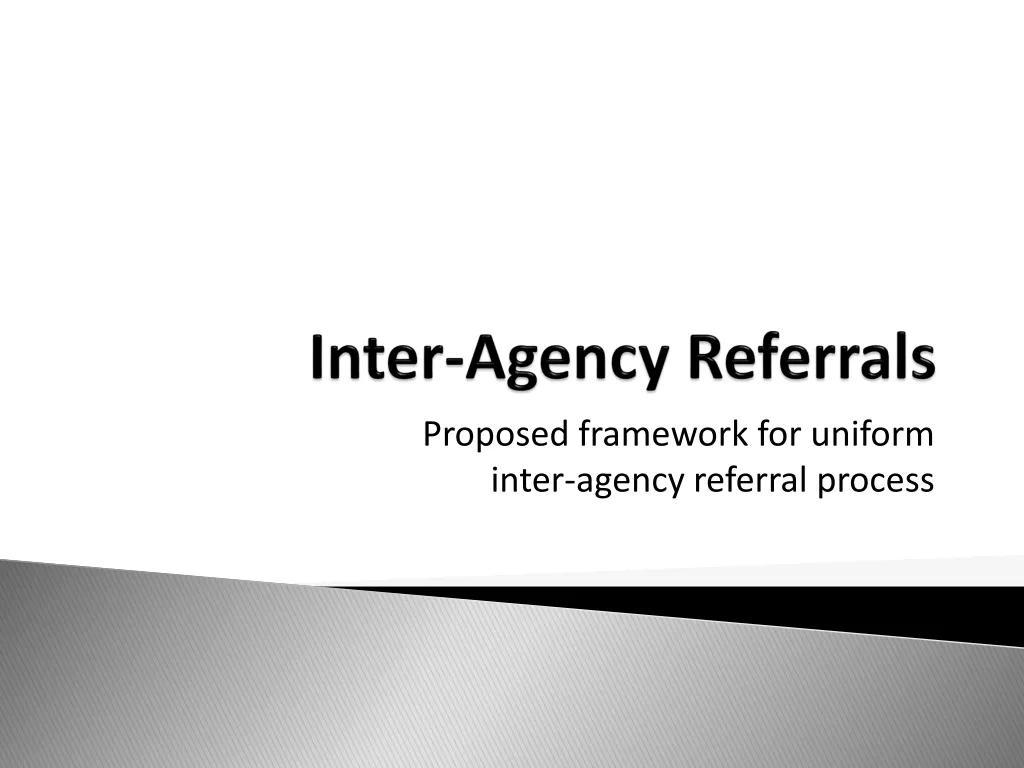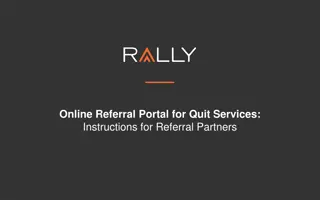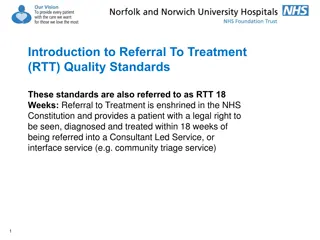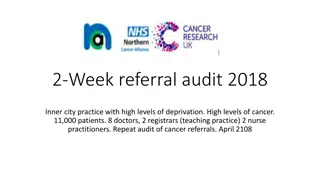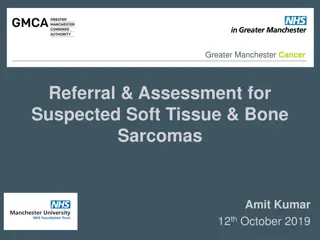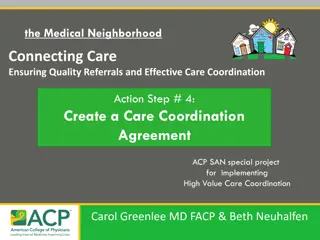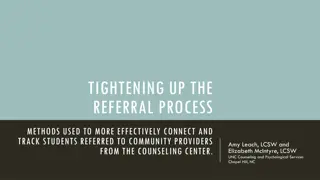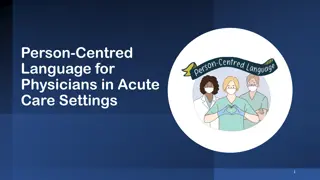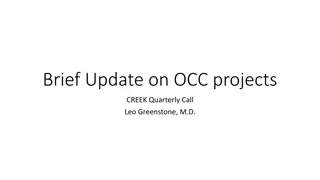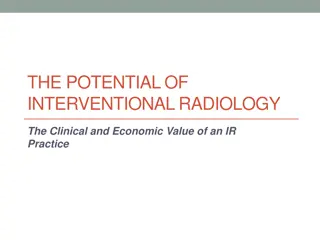Enhancing Care Coordination for Improved Patient Referral Experiences
Explore the importance of patient-centered referral experiences, highlighting the impact of effective care coordination on patient outcomes. Contrasting cases illustrate the difference between non-patient-centered and patient-centered referral processes. Learn actionable steps to ensure all stakeholders receive the necessary information and support for successful referrals, promoting better communication, understanding, and continuity of care.
Download Presentation

Please find below an Image/Link to download the presentation.
The content on the website is provided AS IS for your information and personal use only. It may not be sold, licensed, or shared on other websites without obtaining consent from the author.If you encounter any issues during the download, it is possible that the publisher has removed the file from their server.
You are allowed to download the files provided on this website for personal or commercial use, subject to the condition that they are used lawfully. All files are the property of their respective owners.
The content on the website is provided AS IS for your information and personal use only. It may not be sold, licensed, or shared on other websites without obtaining consent from the author.
E N D
Presentation Transcript
the Medical Neighborhood Connecting Care Ensuring Quality Referrals and Effective Care Coordination Action Step #3 Ensure Others Get What They Need ACP SAN special project for implementing High Value Care Coordination Carol Greenlee MD FACP & Beth Neuhalfen
The ACP SAN High Value Care Coordination curriculum Action Steps to Connected Care 1. Look at your internal referral process (get your own house in order) 2. Ensure the specialty practice gets what is needed for a high value referral 3. Ensure others (patients, the requesting practice and any secondary care) get what they need 4. Develop Care Coordination Agreement(s) (compact) with appropriate referring practice(s) 2
As you listen Consider what is needed (and what to expect) to ensure everyone receives what they need from the referral, including: The patient Needs, goals, understanding, participation The requesting clinician and practice A high value referral response report/note Close-the-loop referral tracking processes The recipients of any secondary referrals that are requested (other specialists, ancillary services) 3
Case: Non-Patient-Centered Referral Experience Pt is given a paper for an intermediate referral for worsening XXX but doesn t really understand why he is being sent. Waits to hear from someone to schedule for 2 weeks but doesn t hear and decides to call his PCP. Specialist office finally calls the patient to schedule in a month but didn t know it was an intermediate referral. When the pt. arrives, the specialist doesn t know why the patient was sent and proceeds to order labs and tests. The patient leaves confused and not sure if he will return because he didn t feel listened to and didn t understand the reason for seeing a specialist to begin with. 3 months later when the patient visits his PCP, the PCP finds out he never went back to specialist ; he did go to the ED with complaints of his condition but his care team was not notified by the ED of the visit. 4
Case: Patient-Centered Referral Experience Patient is referred by his PCP for an intermediate referral for worsening XXX after discussing the goals of the referral and how the appointment will be scheduled The specialist office calls the patient the next day to schedule. The patient is seen within two weeks and when he arrives, the specialist seems to know all about his case. The specialist even knows that his goal is to be active and play with his grandchildren again. They review the labs and tests that were completed prior to the appointment and discuss next steps which involve his PCP. The patient leaves with an understanding of next steps and the specialist sends a report including the plan of care to the PCP. Patient makes his next appointment and feels confidence in his healthcare team. 5
The Patient Experience in the Referral Process My doctor told me why he sent me to see you but I was so upset about the news he gave me that I don t remember what he said. I was supposed to call to schedule with that specialist? I thought her office was supposed to contact me. I understood I was here to have the procedure today, not just to talk about my stomach pain! I had that MRI last month. You mean I was supposed to bring the report and the films with me to this visit? I assumed you had that information. I took the day off of work, drove 2 hours to get here and now you tell me this is not the right doctor for my problem? 6
Patient-Centered Care is more than caring Caring about the patient is central & crucial but Patient (Person & Family)-Centered care also requires delivering care in a Patient-Centered way What does that mean? 7
IOM (Institute of Medicine) Definition of Patient Centered Care Providing care that is respectful of and responsive to individual patient preferences, needs and values, and ensuring that patient values guide all clinical decisions. 8
What matters to the patient We need to attempt to move from what s the matter with our patients to what matters to our patients. Quality of life Their time & their costs Respect, kindness, compassion vs Rudeness, rushing & reproach (blame) Needs & Goals met We need to design care with the patient so it works for the patient 9
Patients take the brunt of the impact for poor referral processes Do not get the time they want or need with the appointment Do not get questions asked or answered; confusion, concerns, etc. Worse outcomes Lost time (patient s time is proposed quality metric) Cost from lost wages, co-pays, deductibles With high deductible plans, patients pay for duplicated, unnecessary care Cost of travel, parking, baby sitter, etc. Delay (hefty cost to mental & physical health) Worry Unable to work, reduced ADL Unresolved or Worsening condition Often get the blame for lack of information with the referral Safety issues 10
The Referral Request - Prepared Patient Patient aware of and in agreement with referral with appropriate expectations (opportunity for Shared Decision Making) Is patient willing to participate in the referral Does patient understand & agree with the reason for referral and understand what additional expertise is needed Are patient s expectations realistic Is patient willing to accept Pre-consultation advice or assistance from specialty care, Including if no appointment required Is e-consult (virtual consult) advice an option patient accepts Does patient have concerns about the referral or the specialty practice 11
The Referral Request - Prepared Patient Consideration of what matters to the patient Patient specific goals What the patient hopes to gain medically (e.g. avoid surgery vs undergo surgery; ensure diagnosis or Rx is correct/optimal, etc.) Goals for life (be able to care for grandkids, travel, etc.) Reading material or other preparation for patient prior to appointment Explaining type of specialty care or procedure Information on referral condition or concerns Flyer from specialty practice about the practice* Logistics / Burden Location/ hours/transportation/appropriate wait time 12
The Referral Request - Prepared Patient Alert specialty care practice of any special considerations or needs for patient / family Language / Impaired vision, hearing, cognition, ambulation, etc. Need to be aware for scheduling, forms, rooming needs Caregiver status Does spouse, adult offspring, case manager, etc. need to be involved in scheduling , in the visit and/or care plan/self-management Transportation Will PCP/Requesting practice help arrange if needed Distance or other considerations (time of appointment, hotel needs) Pain Management Agreement, Advanced Directives, Behavioral Health or Care Management arrangements and contacts 13
The Referral Request - Prepared Patient Use of Referral Guidelines (specific to the patient/condition) Appropriate specialist at appropriate time Appropriate preparation with testing or therapeutic trials prior to referral Patient understands role of specialist and who to call for what Consultation for Advice (PCP to manage) Consultation for Procedure Co-management help from specialist Shared Care (PCP first call) Principal Care (Specialist first call for the condition) Over time the role of specialist may be fluid (change) as disease/ patient changes 14
Template for One Pager for Patient about the Referral - Reduce the Unknowns Patient name_________ Referred on________ Reason for Referral:____________________ Patient Goal____________ Type of referral(role requested of specialty care)*: (recommend have options to be circled) To: Practice name/ physician name(s) - Practice address & phone Info about practice: including link to website for additional info Role Requested of you -the Patient/Caregiver: Wait to be contacted, what to do if... .. Appointment scheduling: will SC practice call, time frame to expect, etc. Visit preparation: Previsit forms, who /what to bring, fasting for test, etc. What to expect: what care team members involved, time allotment, etc. Directions: (bus & train routes & stops; parking & costs; door entrance, elevator bank, floor, etc.) 15
*Type of Referral (Role Requested of SC) options Role Requested of the Specialty Care practice: Do an evaluation & provide advice (consultation) to your physician or care team possibly provide advice directly to your physician without needing an appointment Do a special test, procedure or surgery _____________________________ Specialty care will share in managing this condition, with your primary care team (PCP) taking the lead (you should call your primary care practice first with any problems related to this condition, the primary care team will contact the specialty care team if needed); the specialty care practice may see you to check on the condition 1-2 times per year Specialty care will take the lead in managing this condition (you should call the specialty care practice first with any problems related to this condition) until the condition is stable and then the primary care team can resume management Specialty care will take the lead in managing this condition long-term (you should call the specialty care practice first with any problems related to this condition but maintain your primary care practice for overall care) 16
The Referral Response: What to expect - Ensuring the Patient s Needs are Met Scheduling considerations Use Pre-consultation review to ensure the referral is appropriate If not appropriate, then notify the requesting practice (with reason why) possibly also let the patient know that you have contacted their requesting clinician to reassure or refer to a more appropriate specialty Schedule patients according to urgency or priority of their referral needs Coordination with requesting practice (contact with specialist for urgent referrals with interim assistance) Pre-consultation review with risk stratification of referral needs Build in the capability to schedule according to urgency of referral needs Contact patient within 1-2 weeks to schedule routine referral Accommodate day & time of appointment as possible 17
The Referral Response: Pre-visit Preparation Pre-visit preparation for the appointment Ensure that the needed information received by the time of the appointment Utilize the information sent with the referral to pre-populate the core medical items such as med list, allergies, surgical history, etc. to reduce patient burden then confirm with the patient Provide on-line option or at least at home option for filling out needed forms before the appointment Review of clinical question & supporting data as pre-visit prep by clinician Recommend that clinician share with the patient that they are aware of why the patient was referred and that they have reviewed their records vs asking so tell me why you are here today 18
The Referral Response: Specialty Care can Ensure the Patient s Needs are Met Consideration of what matters to the patient Patient concerns voiced & listened to The patient s story Patient specific goals Medical aspects as well as for their life activities Shared Decision Making for diagnostic or management options The best clinical evidence adapted to the patient s values & preferences the burden of care and patient capacity the patient s needs & circumstances (contextual care) 19
Take Context into Consideration Medical comorbidities Mental or behavioral health needs Patient goals, values, priorities, concerns, fears Cost / affordability Patient s schedule vs the treatment schedule Patient literacy , numeracy and self-efficacy Any impairments (visual, hearing, cognition, ambulation) Food or housing insecurity Transportation needs and availability Caregiver status 20 21
The Referral Response: Ensure clarity of care plan by Patient/Caregiver Explanation of test results and implications Clarity around medication changes & instructions Clarity around care plan instructions & self- management goals Clarity regarding alarm symptoms & who /when to call Clear instructions and expectations with teach back 21
Embrace the Importance of Relationships In Connected Care Caring The secret of the care of the patient is in caring for the patient Peabody Curiosity & Compassion Do we meet each person curious about the miracle of a human being that we are about to connect with? Senge Connection, Cooperation & Camaraderie being part of a great team most striking is the meaningfulness of the experience being part of something larger than themselves, being connected being generative Senge 22
Put it into action. Primary care practice identify how they can include the patient s goal(s) in the referral request Encourage Specialty Care practices to develop a one pager on their practice for the primary care practice to provide to patients when the referral is made Consider having practice do a patient experience survey about the referral process or solicit patient input on the practice s referral process 23
Meeting the Needs of Requesting Clinician and Practice what to expect A high value referral response report or note Perform an audit of specialist s referral response Ensure presence of critical elements & clarity Ensure critical information easy to access (location) Close-the-loop referral tracking processes Create the process & any needed forms Assign roles & responsibilities Track the process 24
Antithesis of High Value Coordinated Care: Antithesis of High Value Coordinated Care: Case 1: referred to cardiology with unexplained DOE. 28 page note from the cardiologist only ICD codes for impression no indication of what the cardiologist thinks or is going to do or what s/he recommends the PCP do 59 yo man with T2DM, HTN, Hyperlipidemia & obesity Disconnected Care More questions than answers Safety concerns 25
High Value Referral Response Answer the clinical question/address the reason for referral Summary or Synopsis (include some thought process) Agree with or Recommend type of referral / role of specialist Confirm existing, new or changed diagnoses; include ruled out Medication /Equipment changes Testing results, testing pending, scheduled or recommended (including how/who to order) Procedures completed, scheduled or recommend Education completed, scheduled or recommended Any secondary referrals made (confer with and/or copy PCP on all) Any recommended services or actions to be done by the PCMH Follow up scheduled or recommended 26
Antithesis of High Value Coordinated Care: Antithesis of High Value Coordinated Care: Case 2: 54 yo male with thyroid nodule evaluated by endocrinologist with report to PCP indicating FNA shows Papillary Thyroid Cancer. Needs surgery. F/u appt with PCP a year later shows thyroid intact and nodule still palpable Risk: Delayed care: potential harm to patient Liability concerns 27
Referral Response: Critical Elements Answer the clinical question/ address the reason for referral Summary or Synopsis (include some thought process) Clear indication of diagnosis/evaluation &/or the treatment plan What is the specialist going to do What is the patient instructed to do What does the referring physician need to do & when What follow up is needed and with whom 28
High Value Referral Response Make the referral response easy for the referring practice to review & utilize ( user friendly ) Do not want to contribute to data dump problem (send multiple page report where the referring physician cannot easily access critical information) Set up protocol with referring clinician/team that critical elements will be placed in a specific part of or location in the referral response report e.g. under Assessment and Plan Sign note with A&P at top of note 29
Synoptic Referral Response Answer to clinical question:Based on her need for mealtime insulin but reluctance/inability to administer injections during work day as first grade teacher, we have opted for her to try Premixed insulin before breakfast and dinner Type of referral: agree with Shared Co-management Diagnosis: no change Testing: pocA1c 9.6% Medication changes: Stop Lantus insulin Start Humalog mix 75/25 as 20 units before meals twice daily Equipment changes: none Self management: Titration sheet for insulin adjustments Patient to measure BG before lunch and at bedtime and FBS F/U: 2 weeks with endocrine and then in another 4 weeks with PCP 30 34
Example: Nephrology referral response for evaluation of 36yo male with Type 1 diabetes with Cr 1.9 and K+ 5.7 Impression: Stage 3 CKD due to type 1 diabetes and HTN with no evidence of additional autoimmune renal disease Impression: Stage 3 CKD Plan: Recommend change from ACEI to CCB Plan: Shared Care with annual f/u Recommend change from ACEI to CCB due to persistent significant hyperkalemia due to type IV RTA & to delay renal replacement Why ? Who does what ? I have provided script for amlodipine 5 mg qd with refills x11 What is plan for f/u and which provider ? He is to see you for BP check and Renal Panel in 1 month to recheck K+ and Cr Please feel free to contact me if K+ still elevated or BP not controlled Provided handouts on CKD to patient 31
Take a minute For Referral Response notes that you receive How/where do they come in? Who reviews? How are recommendations incorporated? Consider what you might need to request from the specialty care practices that you refer patients to Are the critical elements included? Is the rational for the recommendations explained? Is critical information easy to find in the note? 32
Open Loop Open Ended 53 year old man had skin lesion resected by PCP Pathology showed melanoma Referred to Dermatology for the needed further management Patient was No Show for Dermatology appointment and neither clinician was aware 33
REASONS FOR NO-SHOWS Overscheduling/forgetting about appointment Feeling that condition has worsened and opting to go to the emergency room instead Not understanding why appointment is necessary A limited relationship with their physician making them less concerned about skipping an appointment A language barrier that causes them to misunderstand when appointment is scheduled Socio-economic factors Worries about receiving bad news and hoping to avoid the situation Some patients may simply feel better and not need the appointment, but fail to notify the office. Usually not defiance or being a contrarian Annals of Family Medicine 34
Referral Tracking Closing the Loop Referral request sent, logged & tracked Referral request received and reviewed referring practitioner notified: Referral accepted with confirmation of appointment date & time (note if patient on a move up list) If request is a secondary referral, include PCP in notification (e.g. patient referred by endocrinology, GI, cardiology to surgery) Notify if appointment is moved up or re-scheduled Ask for additional information if missing critical items or special request to aid & expedite assessment or management Need process to track to ensure that all missing/ special request information is received 35
Referral Tracking Closing the Loop Referral request received and reviewed referring practitioner notified, continued: Referral declined due to inappropriate referral (wrong specialist, further assessment &/or management not indicated ) As the requesting practice, how do you recognize this? Who sends referral request to the appropriate specialty? How is this communicated to the patient ? Patient defers making appt or cannot be reached If unable to contact patient, confirm correct contact information Establish time frame for notifying requesting practice based on urgency of the referred condition 36
Referral Tracking Closing the Loop Referral response sent - Referral Note (report) sent to requesting clinician &/or PCP Ensure Addresses clinic question or reason for referral Sent in timely manner (usually considered within 1 week of visit) Process for notifying requesting practice and/or PCP of test results that come back after the referral response note sent Notification of No Show or Cancellation If patient cancelled, include reason for cancellation if known Notice of NO SHOW and any policy on rescheduling As the requesting practice how do you handle No Show (or cancel w/o rescheduling) for referral appt policy & procedure in place? 37
Referral Tracking Closing the Loop Self-referred patient Self-referral request received and reviewed by SC Handle c/w practice policy Clarify reason for referral / clinical question Ensure appropriate specialty Attempt to get records in advance Referral response sent - Referral Note (report) sent to PCP and appropriate other clinicians (unless patient has strong objections despite reassurance) 38
Put it in action. Identify team member(s) for the role & responsibility of closing-the-loop for referral requests sent by the practice Determine how the practice will track the close-the-loop process Create any needed logs and/or forms for the close-the-loop process Make it part of the referral process for the practice How do you handle incomplete referral requests (never scheduled, cancelled w/o rescheduling, no shows)? 39
The Referral Black Hole 84 yo man with upper extremity radicular pain referred by his PCP/ PCMH to Neurosurgery for possible spinal stenosis MRI shows Cervical DJD & a large thyroid mass Neurosurgeon notes MNG with 4 cm thyroid nodules Refers to Endocrinology Does FNA of thyroid nodules Cytology benign but surgery discussed Refers to ENT Schedules surgery for thyroid 40
The Referral Black Hole continues ENT refers to another Primary Care practice for pre-op clearance Patient s PCP learns of planned procedure from a hallway conversation-arranges follow-up with patient Patient asks PCP if thyroidectomy will relieve his neck and shoulder pain 41
Secondary Diagnoses Another disorder related to or unrelated to the reason for referral Can be diagnosed during evaluation of referral condition Can be related to the specialty area or not Can be brought up by patient complaint or history Can be related to the specialty area or not 42
Secondary Diagnoses Another disorder related to or unrelated to the reason for referral Suspected Sleep Apnea in a patient referred for cardiac disease Rash in a patient seen by General Surgery re gallbladder Headaches in patient seen by GI for diarrhea or constipation Celiac disease in a patient referred for severe osteoporosis GERD symptoms in patient seen for hyperthyroidism Hemochromatosis in a patient referred for diabetes with hypogonadism Heart palpitations in patient seen by ortho for knee pain Hepatitis C in a patient referred for Sjogren s Knee pain in patient seen by cardiology for heart palpitations GERD in patient referred for hoarseness 43
Recommendations: Handling Secondary Diagnoses Pending Care Coordination Agreements Secondary diagnosis discovered as part of the evaluation of the referred condition & related to the referred condition & in specialist s field of expertise Specialist assumes management (e.g. Cushing s Syndrome discovered during evaluation of severe osteoporosis by endocrinology) All other Secondary Diagnoses are best handled by deferring to or at least first conferring with the Primary Care team (even if it is something that falls under the specialty sphere) 44
Ensure Appropriate & High Value Secondary Referrals Secondary referrals arise from a referral request to another specialty/ subspecialty practice for consultation, procedures, or co-management by a specialty practice (by one specialty practice to another specialty practice) In some instances, the referral for special services may require some specialty knowledge and may best be managed by the specialty/subspecialty practice - examples: endocrinology referring to endocrine surgery for pheochromocytoma; cardiology referring to cardiothoracic surgery for valvular heart disease; GI referring to surgery for bowel resection for refractory Inflammatory Bowel Disease 45
Secondary Referrals OB GYN to Perinatology or GYN Oncology Rheumatology to Hand Surgeon or Physical Therapy Endocrinology to Nuclear Medicine or Ophthalmologist GI/Endocrine/Cardiology/Oncology to Surgery Appropriate Secondary referrals (related to principal condition) can expedite care (if allowed by insurance plan policy) Inappropriate Secondary referrals waste resources (e.g. referral to a non-related specialty vs back to Primary Care) 46 51
Communicate to Ensure Appropriate Secondary Referrals There needs to be clear expectations for when the PCP wishes (or is required by insurance plan) to be involved in secondary referrals & when it is preferable for the specialty/subspecialty practice to proceed without conferring with PCP (if allowed by insurance plan) Controlling/reducing the referral black hole is critical for new payment models based on TCOC In all cases, the PCP needs to be included in the communication regarding the secondary referral & the outcomes of that referral a process for ensuring this communication connection needs to be established 47
If/when specialty care makes a Secondary Referral Request Should be sure to Include the Patient s PCP/ PCMH in the decision or at least cc on the referral request Include critical elements of a high value referral request: Prepared Patient Type of referral Clinical question Urgency Core Data Set Pertinent Data set Track the referral request until reconciled 48
Take a minute. Do you have a referral black hole problem? Are you included in the loop/ are you conferred with or notified when your patients are referred to another specialty care practice? How do you prefer to be asked / notified about secondary diagnoses? e.g. Oncologist suspects patient has OSA and wants you to evaluate e.g. Orthopedist notes elevated BP 49
Take a minute. As you establish Care Coordination Agreement Determine which secondary diagnoses might be appropriate for the SC practice to evaluate/manage for referred patients Or when handling these secondary diagnoses expedites care Identify when a secondary referral request from the specialty care practice is appropriate (requires specialty expertise and expedites care) (and how to know when insurance plan requires PCP to refer) Ensure PCP is included in the communications involving the Secondary Diagnoses & Referrals 50
